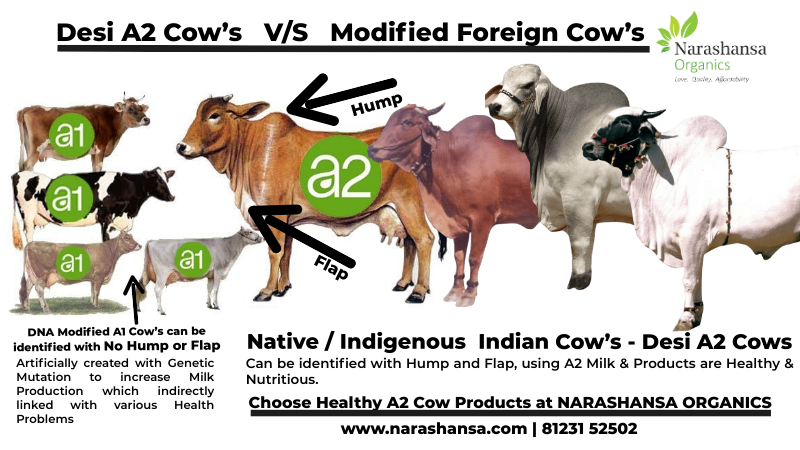
Unlock the Secret to Better Health: Why A2 Cow Milk is Your Best Choice
A1 milk, derived from hybrid dairy cows, has been linked to various health concerns. In contrast, A2 milk, produced from native Indian cow breeds, offers several potential health benefits. This blog explores the differences between A1 and A2 milk and explains why making the switch could be advantageous for your health.
Difference Between A1 and A2 Milk:
- A1 Milk: Produced from cows with a larger udder size due to hybrid breeding. This can lead to health issues like mastitis, which affects milk quality and can contribute to conditions such as heart disease and diabetes. Source: Scientific Research
- A2 Milk: Comes from native Indian breeds such as Gir and Vechur. A2 milk lacks the harmful A1 beta-casein protein, offering a healthier alternative. Source: Research Article
Health Risks of A1 Milk:
- Dairy cows producing A1 milk often have udders that are 5 to 6 times the size of their natural counterparts, leading to conditions like mastitis. This can negatively impact both cow health and milk quality. Source: Medical Study
Benefits of A2 Milk:
- Nutritional Advantages: A2 milk is associated with fewer digestive issues and offers better health outcomes compared to A1 milk. Source: Health Benefits
- Support for Local Farmers: Choosing A2 milk supports traditional dairy farming practices and helps conserve native cow breeds. Source: Ayurvedic Perspective
Current Issues in Dairy Industry:
- The dairy industry is increasingly facing issues related to homogenization, pasteurization, and cross-breeding with imported breeds, affecting the quality of milk. Source: Industry Report
Conclusion: Switching to A2 milk from native Indian breeds offers numerous health benefits and supports sustainable dairy practices. It is a worthwhile choice for both your well-being and the environment.
Explore More: Visit Our Website
Follow Us:
- Instagram: narashansa.organics
- Facebook: Narashansa Organics
- LinkedIn: Narashansa Organics
Contact Us:
- Email: narashansaorganics@gmail.com
- Phone: +91 81 231 52 502
Insights on A2 Milk and Native Indian Breeds
- Support for Native Farmers and Health Benefits:
- Native Breeds: A2 cow milk comes from native Indian breeds such as Zebu (Gir, Vechur). These breeds are less manipulated by modern agricultural practices and are closer to their natural state.
- Healthier Choice: Consuming milk from these breeds supports not only the cows’ well-being but also your own health, as it is free from hormones and genetic modifications. This aligns with the concept of “Healthy Cows & Healthy You.”
- Economic and Environmental Impact: Supporting native farmers who use these breeds contributes to sustainable agriculture and helps preserve traditional farming practices.
- Current Trends and Issues in Dairy Farming:
- Global vs. Local Practices: While dairy industries worldwide are working to develop A2 protein in cattle, Indian policy makers and farmers seem to be less focused on this trend, potentially missing out on benefits associated with A2 milk.
- Cross-Breeding Issues: Cross-breeding of native breeds with imported breeds can introduce A1 beta-casein protein into the milk, which may negate some of the health benefits of traditional A2 milk.
- Concerns with Modern Dairy Practices:
- Processing Effects: Milk that is homogenized, pasteurized, grain-fed, antibiotic-fed, or treated with growth hormones loses some of its natural benefits. Raw, grass-fed milk from Zebu cows offers a more authentic and nutritious option.
- Preservation of Traditional Practices: Maintaining traditional dairy practices, such as feeding cows grass rather than grains and avoiding artificial additives, is crucial for preserving the quality of milk.
- Future Outlook:
- Dependency on Western Practices: There is concern about the potential future reliance on western dairy farms or cross-bred cattle for milk, which could compromise the benefits of traditional Indian breeds.
- Call for Awareness: It is essential to stay informed about the unhealthy practices in milk processing and the impact of modern agricultural methods on milk quality.
Conclusion:
Embracing A2 milk from native Indian breeds supports both personal health and the well-being of traditional farming practices. It is crucial to avoid modern processing methods that can diminish the nutritional value of milk and to advocate for the preservation of traditional dairy practices.